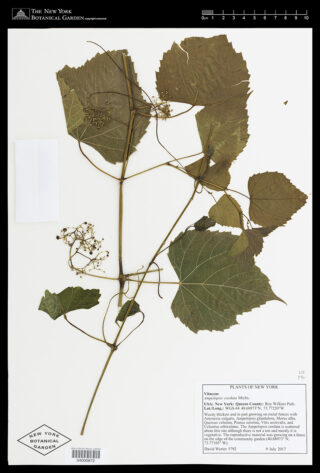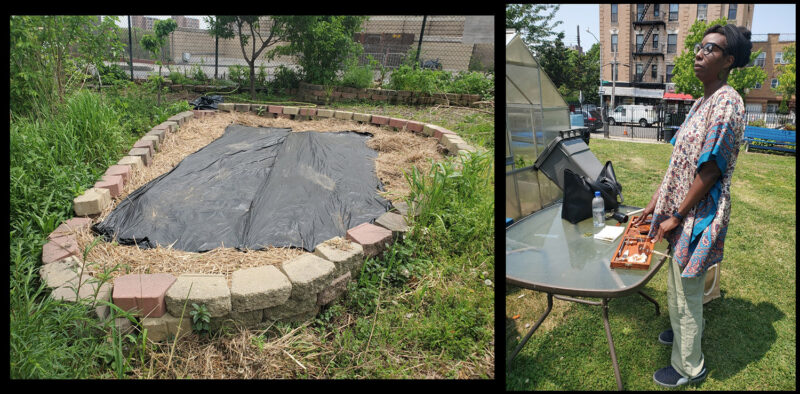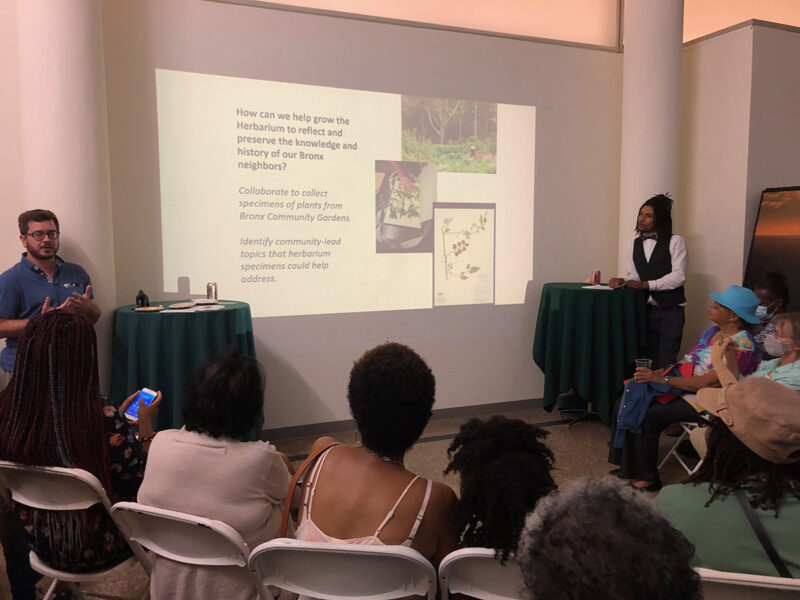NYBG Welcomes Community Gardeners into the Herbarium as Knowledge-Holders in Ecological Stewardship
Audrey Jenkins is a Mellon Research Fellow at The New York Botanical Garden.

Digital herbarium specimen of Ampelopsis cordata (heartleaf peppervine) collected from the outside of a community garden fence in Roy Wilkins Park, Queens, NY, by David Werier, 2017
This spring, I helped launch a new initiative at NYBG to collaborate with community gardeners on local biocultural research and preservation. This project aims to partner with and support gardeners and other community members interested in conducting and exploring ethnobotanical research, including through Herbarium specimen collection in community gardens. From a collections standpoint, the goal is fairly routine—fill a gap in the data. Despite containing an astounding 7.8 million plant specimens from all over the world, the William and Lynda Steere Herbarium lacks representation of the rich biocultural diversity right in its own backyard. At the time of writing, the Herbarium could boast of only one known specimen taken from a community garden: an Ampelopsis cordata (a.k.a. heartleaf peppervine) sampled from the outside of a garden fence in Roy Wilkins Park in Queens, NY.
However, the Community Gardeners + Herbarium Initiative spearheaded by an interdisciplinary team from the Herbarium, the Humanities Institute, Bronx Green-Up, and the Office of Diversity and Inclusion is anything but routine. While The New York Botanical Garden has long provided public access to continuing education, cultural enrichment, research resources, and a range of other botanical programming, there has not been a wide institutional effort to collaborate with local community members on research, preservation, and celebration of community-based plant knowledge and relationships. Since 1988, NYBG’s Bronx Green-Up program, which provides people power, garden supplies, and compost and horticultural training and support to community gardens, has maintained close relationships with gardeners across the borough, but those relationships have historically occurred beyond the bounds of Bronx Park and have been largely siloed from other NYBG activities. Rarely have community gardeners or other community members been invited into the Garden as research and project collaborators.
There are signs of change: in 2021, the Humanities Institute launched the Bronx Foodways Oral Histories Project in collaboration with Bronx Green-Up and has captured the stories of 20 Bronx community gardeners so far. The Institute has also held workshops in community gardens, including the Fire Cider and Honey Infusion events led by Samrah Shoaib in Taqwa Community Garden and New Roots Community Farm respectively. NYBG has also hosted events in collaboration with Bronx-based knowledge-holders, like Journei Bimwala who shares her knowledge of plant uses such as medicines. Yet, more dynamic and sustained research partnerships between NYBG and the vast network of community gardeners, plant lovers, creators, and citizen scientists are limited.
This disconnection is a detriment to NYBG and the wider Bronx and New York City communities, stymying information and resource flows in both directions and preventing opportunities for feedback and co-creation between experts in the community and those at NYBG. For the community, this can mean fewer opportunities to support neighborhood efforts like improving environmental conditions, strengthening local advocacy, and connecting to knowledge and ideas through the international networks that botanical gardens foster. Participation in NYBG’s research and educational activities, including the documentation of local biocultural diversity via the collection and preservation of herbarium specimens, allows for greater education, representation, and investment in conservation and ecological science for and by Bronx residents. For NYBG, the disconnection means missing out on opportunities to learn from local ethnobotanical landscapes and to tailor resources to the community, which could increase the Garden’s value in the eyes of local stakeholders. In their book Public Gardens and Livable Cities (Cornell University Press, 2020), Donald Rakow, Meghan Gough, and Sharon Lee describe botanical gardens as “anchor institutions” that can promote the environmental, health, economic, educational, social, and cultural wellbeing of neighborhoods by strengthening community knowledge, skills, resources, and networks. They point to numerous examples of impactful partnerships between botanical gardens and local communities in NYC and elsewhere that promote environmental knowledge and action, and ultimately strengthen the social value of botanical institutions. This “anchor institution” role is becoming increasingly important with climate change and other environmental challenges, but Rakow, Gough, and Lee emphasize the necessity of community leadership in guiding institutions’ strategic efforts. With the recent appointments of Dr. Mauricio Diazgranados as Chief Science Officer and Dr. Eric Sanderson as Vice President of Urban Conservation Strategy, NYBG is making moves to increase its focus on urban resilience. As NYBG works to provide guidance and support for local ecological stewardship (and beyond), cultivating stronger reciprocal relationships with a diverse network of community partners will go a long way.
The benefits of partnering with community gardeners and neighbors are layered. First, communities have lived and studied experiences cultivating, preserving, and using plants from all over the world while stewarding local land. New York City has over 500 community gardens where many immigrant and trans-geographical gardeners grow culturally relevant plants not otherwise commonly cultivated in the New York region. At the same time, community gardeners also share and learn with each other, meaning they are discovering and often seeking out new plant relationships and knowledge. For example, at New Roots Community Farm funded by the International Rescue Committee (IRC), refugee gardeners experiment with cultivating various locally uncommon plants which the garden may adopt if successful, such as with New Roots’ recently installed rice paddy. The gardeners at Kelly Street Community Garden, who experiment with acclimating non-local plants as well (such as Rose Nzapa-Ayeke’s bissap), manage an herbal apothecary sourced from the garden to provide communal access to medicine and herbal knowledge in their neighborhood. Textile designer Sajata Epps, who gardens at and uses plant dyes from El Flamboyan Community Garden for her textile and environmental artworks, explores the properties and potentials of natural fibers and dyes. There is a lot to learn from these pioneers.

Rice paddy at New Roots Community Garden (left); Sajata Epps at El Flamboyan Community Garden demonstrating cotton spinning on a book charkha (portable spinning wheel invented in India during colonial resistance)(right)(photo credit: Audrey Jenkins)
Second, community residents know the histories, social dynamics, needs, and strengths of their own communities. Their insights to what is needed for successful programming are critical for planning and implementation. For example, community gardeners learn not only what they themselves like to grow, eat, and use, but also the diverse interests of neighbors, such as locals getting produce from gardens’ food boxes and farm stands like those at the Garden of Happiness, New Roots, Kelly Street, and Morning Glory Farm. This is important because food and the other things grown in community gardens can promote personal, social, ecological, and intergenerational wellness and connection through sharing of environment, food, medicine, culture, knowledge, care, and related practices. As Karen Washington mentions in her oral history, it’s important that urban agriculture reflect and be led by the holistic interests of the community, not just singular goals of food security or productivity. Developing more systemic working relationships with community members opens up possibilities for organic collaboration and information sharing around the implications and potentials of programming at NYBG.
Third, sustained reciprocal relationships require trust and mutual respect that enables future opportunities for engagement, collaboration, and program success. NYBG’s Bronx Green-Up team knows this from its 35 years of experience. Bronx residents and other New Yorkers deserve trust that NYBG is going to have their best interests at heart. A city of majority immigrants, Black, brown, indigenous, and other People of Color who continue to experience the consequences of research practices rooted in extractive economies, many community members question NYBG’s intentions. Not all community knowledge may feel safe with an institution like NYBG. How might sharing plant knowledge ultimately impact communities’ access to those valuable plants? As NYBG becomes a partner in conservation and related local social justice efforts, learning from and supporting community members as equals in knowledge generation, preservation, and sharing is critical.
In light of this, the new Community Gardeners + Herbarium Initiative focuses on reciprocity and the establishment of an ongoing dialogue in collaboration with community gardeners. The initiative officially kicked off on Friday, June 2, 2023, when the Garden welcomed over 40 community members into the Herbarium for tours of the mounting room, digitization lab, and collections, as well as refreshments and an initial dialogue around community interest in accessing and using the Herbarium and other NYBG resources. The event was promoted through the Bronx Green-Up email list, an in-person announcement at the Humanities Institute’s Honey Infusion workshop in May, and word-of-mouth. At least 10 different community gardens were represented at the event.

At the Community Gardeners + Herbarium Initiative kickoff event on June 2, 2023, Matthew Pace and Kenneth R. Otero-Walker of the William and Lynda Steere Herbarium present on the value of community involvement in herbarium collections. (photo credit: Ursula Chanse)
The project team and I are grateful for community members’ interest in this initiative so far. It was exciting to see so many gardeners at NYBG for the kickoff, but we are eager to bring the conversation and workshops out to community gardens around the borough. Next events will hopefully consist of combined skillshares and dialogues, with possible topics including plant pressing and preservation, herbarium specimen making, the value of community herbaria, archiving, and other topics suggested and hopefully co-led by community members. At the same time, the dialogue at the kickoff and conversations with community members afterward have begun to inform what community relationship building at NYBG can mean, for example: communications and engagements must be accessible and intentional to truly welcome diverse community members to the table; and knowledge should be appropriately protected and stewarded in partnership with community members themselves. The project must also have reliable support and resources to enable interdisciplinary collaborations within NYBG, shaking up certain formalized silos between research and programs. We look forward to expanding this collaboration across both the city and NYBG in months and years to come.
Community members and NYBG departments interested in getting involved or learning more can email me (ajenkins@nybg.org) and Bronx Green-Up (bronxgreenup@nybg.org) to get on the project listserv for upcoming events and announcements. We also encourage community members to check out the following resources to learn more about NYBG’s research and program activities:
- Tour the Herbarium: please get at least 5 people together for the tour and then email Nicole Tarnowsky (ntarnowsky@nybg.org) and Matthew Pace (mpace@nybg.org) to schedule a day/time. In addition, thousands of herbarium specimens are accessible online at the V. Starr Virtual Herbarium.
- General admission to the Garden grounds is always free to Bronx residents via the Bronx Neighbors Program.
- Bronx residents can get a Library card and check out books (it’s a public library!) at the Mertz Library, which focuses its collections on plants and other botanical subjects. Explore the library online or onsite!
- Upcoming NYBG events on the calendar.
Audrey Jenkins is a Ph.D. student in Public and Urban Policy at The New School’s Milano School of Policy, Management, and Environment, where she studies community gardens as a form of democratic urban infrastructure. Audrey was a Mellon Research Fellow at NYBG’s Humanities Institute within the Mertz Library from 2022–2023.
*When first published, the article reflected the Initiative’s original focus on communities in the Bronx. Because the Initiative refocused soon after to include communities beyond the Bronx, the article was edited slightly in December 2023 to better communicate these goals with community members.
SUBSCRIBE
Enter your email address to subscribe to this blog and receive updates on new posts.











